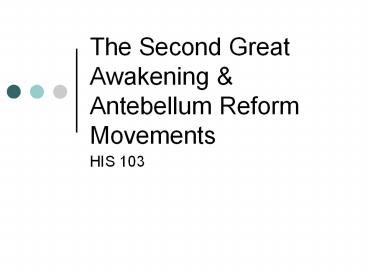The Second Great Awakening - PowerPoint PPT Presentation
Title:
The Second Great Awakening
Description:
The Second Great Awakening & Antebellum Reform Movements HIS 103 * * * * * * * * * * * * * * * * * * * Threats to Protestantism Elites abandoned orthodox Christianity ... – PowerPoint PPT presentation
Number of Views:197
Avg rating:3.0/5.0
Title: The Second Great Awakening
1
The Second Great Awakening Antebellum Reform
Movements
- HIS 103
2
Threats to Protestantism
- Elites abandoned orthodox Christianity
- Most Founding Fathers were Enlightenment Deists
- Believed in creator God
- Rejected divinity of Jesus miracles
- Believed mans reason could figure everything out
- Unitarians split Congregational establishment in
New England - Took control of Harvard wealthiest urban
churches - Est. American Unitarian Association in 1826
- Catholic Lutheran immigrants practiced
different forms of Christianity - Transcendentalism emphasized individualism
emotion/intuition over reason - Ralph Waldo Emerson
- Henry David Thoreau (Walden, Civil Disobedience)
3
Colonial Protestant Establishment Unable to Meet
Changing Conditions
- Insistence on educated clergy worked against
needs of the frontier communities - Clergy tended to have middle-class disdain for
uncouth frontier life - Calvinist theology too complex restrictive for
uneducated poor people - Disestablishment 1st Amendment created
competition among denominations - Only by using non-seminary-trained ministers
could demand be supplied - 1775 1,800 ministers (11,500)
- 1845 40,000 ministers (1500)
- Revivalists used democratic rhetoric to attack
aristocratic religious elites
4
Second Great Awakening Methodists
- Methodism came over to America after successfully
transforming Great Britain in the late 1700s - John Charles Wesley began reform movement
within the Anglican Church later became
Methodist Episcopal Church - Francis Asbury was 1st Methodist Bishop in the
U.S. - Peter Cartwright was leading circuit rider
- preached salvation as a free gift to all
- Set up Sunday Schools bible studies
John Wesley
Francis Asbury
5
The Spread of Methodism
6
Methodist Camp Meeting
7
Second Great AwakeningBaptists
- Baptists also spread rapidly
- Rejected Calvinist roots
- John Leland combined Jeffersonian democracy with
Christian morality - Both groups used popular mass culture
- Took advantage of cheap printing to produce
Bibles, tracts, Sunday School curricula, etc. - Took popular songs and wrote new lyrics
- Created interdenominational organizations
- American Bible Society
- American Sunday School Union
- American Tract Society
Leland Cheese Monument Cheshire, Mass.
8
Challenging Race Gender Conventions
- Initially preached racial gender equality
- Women blacks allowed to preach
- Later backed off due to concern for
respectability - Richard Allen founded Bethel African Methodist
Episcopal Church (A.M.E.) after whites tried to
segregate St. Georges Methodist Church in
Philadelphia
Richard Allen
Mother Bethel AME Church
9
Revival Preaching
10
Congregationalists Presbyterians
- Presbyterians Congregationalists adopted
methods by 1830s-40s, bringing revival to
Northeast - Lyman Beecher traveled around preaching
conversion - Charles G. Finney developed system for revival,
deliberately playing on emotions - Converted 100,000 people in Rochester, NY in 1839
Charles G. Finney
11
Come-Outer SectsMormons
- Church of Jesus Christ of Latter-Day Saints
(Mormons) - Joseph Smith, Jr. saw angel Moroni found in
gold tablets in 1823 - Book of Mormon published in 1830
- Established utopian communities
- Kirtland, OH 1831-38
- Nauvoo, IL 1839-45
- Hierarchical, male-dominated church
- Polygamy encouraged
- Smith killed by mob in Nauvoo, Illinois in 1844
- Brigham Young led migration to Deseret (Utah) in
1846-48
Joseph Smith, Jr.
Brigham Young
12
Hill Cumorah, Palmyra, NY
13
Reconstructed TempleNauvoo, Illinois
14
Mormon TempleSalt Lake City, Utah
15
Come-Outer SectsShakers
- United Society of Believers in Christs Second
Appearing (Shakers) started in England in 1747 - Mother Ann Lee Stanley claimed to be 2nd, female
incarnation of Jesus Christ - Came to America with 8 disciples in 1774
- Established 19 communities between 1783-1836
- 4,000 5,000 members at peak
- Lived communally practiced celibacy
- Danced experienced ecstasies in worship
- Embraced modern technology
16
Shaker Dance
17
Round Barn (1826)Hancock Shaker Village
18
Mill Powered by Water TurbineHancock Shaker
Village
19
Weave ShopHancock Shaker Village
20
Elders BedroomHancock Shaker Village
21
Oneida Community
- Oneida Community founded by John Humphrey Noyes
in 1848 - Noyes had been converted by Finney, but became an
antinomian - Complex marriage came to be eugenic breeding
program - Noyes fled to Canada in 1879 to avoid adultery
charge - Community became a joint-stock company in 1881
John Humphrey Noyes
Oneida Community Mansion
22
Antebellum Reform Movements Abolition
- American Colonization Society (1817) favored
gradual, compensated manumission returning
freed blacks to Africa - Liberia founded in 1821
- 6,000 immigrants, 1817-67
- American Antislavery Society (1833) demanded
immediate, uncompensated emancipation black
citizenship - William Lloyd Garrison began publishing The
Liberator in 1831 - Frederick Douglass was escaped slave who became
eloquent spokesman
William Lloyd Garrison
Frederick Douglass
23
Antebellum Reform Movements Temperance
- Temperance movement combated widespread evils of
alcholism - American Temperance Society Washington
Temperance Society led voluntary individual
reform efforts - Parades featured water wagons
- Teetotalers pledged total abstinence
- Per capita consumption drastically reduced by
1850 - Neal Dow got 13 states to pass Maine laws,
1851-55 - Prohibited manufacture sale of intoxicating
liquor - Did not apply to beer, wine or cider
24
Antebellum Reform MovementsWomens Rights
- Womens Rights movement grew out of other reform
movements - Many, like Susan B. Anthony, were Quakers
- Elizabeth Cady Stanton began as temperance
advocate abolitionist - Seneca Falls Convention (1848) issued Womens
Declaration of Independence
25
Antebellum Reform Movements Penitentiaries
Asylums
- Criminals, poor, etc. seen as result of societal
failure - Penitentiaries designed to remove criminals from
corrupting influences provide discipline
through labor - Auburn (1819-23)
- Ossining (1825)
- Asylums isolated patients from outside influences
in order to cure them - Mental illness viewed as result of stress
- Asylums were utopias
Dorothea Dix































